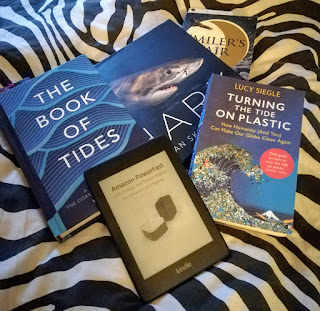Marine Creature of the Month September
I have realised that I am a little bit scared of octopuses*. I don't know if it's their fluidity or the fact I had a dream where one was stuck to my sister's leg or what... But I thought doing some research into the smallest, therefore cutest, octopus would help me love them a little. It's done a pretty good job, I'd say. So let me introduce you to the...
Atlantic Pygmy Octopus
 |
| Photo from Everything Octopus |
Kingdom: Animalia
Class: Cephalopoda
Conservation Status: Least Concern (LC)
Found: The Atlantic; Caribbean, Cayman Islands
Diet: Carnivorous; clams and crustaceans
Weight: 30g (1oz)
Size: Mantle - 4.5cm (1.8in); Arms - 9cm (3.5in); Total - 13.5cm (5.3in)
Habitat: Warm, coastal waters, shelf and sea bed
It is a widely known fact that octopuses are very intelligent creatures. They are often escaping aquariums, there was that one which predicted the 2010 World Cup, and they are Professor Layton level puzzle solvers. Atlantic Pygmy Octopuses are no exception. These curious little critters are confident around humans, although very good at playing hide and seek. They are known to use problem solving to make their environment better suit their needs. Quite often this means seeking cleaner waters. They will purposely move away from polluted waters as they thrive better away from pollution. I know this is true of all fish, the Atlantic Pygmy Octopus just knows how to solve the problem. I think it makes them very tiny environmentalists in a way. Unfortunately for them, the serious pollution levels in our oceans does mean their viable habitats are getting smaller.
They live in warm, coastal waters in the Atlantic, found off the coast of number of countries. They live on the sea bed in the continental shelf. This is the stretch of land which is still technically the continent, it has just been submerged under relatively shallow water. These areas are usually teeming with life, as it has good light which provide plant life with enough energy to photosynthesise. They then support the food web as the primary source. I'm sure we all remember drawing that diagram in primary school!
The Atlantic Pygmy Octopus, however, is a carnivore. Despite its tiny stature, they have devloped a brilliant means of getting all they food they need. They eat shellfish, clams and crustaceans mostly. And how does this critter, which is about the length of a Sharpie marker, manage this? With the help of its radula. This is a small, spikey, tongue-like structure inside its beak which it uses to bore into the shell of its dinner. Once a hole has been made, they secrete some poisonous saliva to paralyze their prey. After that, it's time to eat! They are, however, limited to small shellfish. They can't eat Japanese Spider Crabs!
Being so small, they are prone to other predators. Like all octouses, they have two very effective defense mechanisms. These are being able secrete ink and camouflage. They can achive a seamless camouflage thanks to pigmented and light reflecting cells on their skin, which change their colour and texture with rapid precision. In addition to these great defenses, the Atlantic Pygmy Octopus is fantastic at hiding. They'll hide from predators in any gap which will have them - clams, small openings, even inside cans. Most ingenius is that they use their arms to gather sand and gravel to close the opening, effectively making a lid. They are hidden and they are safe.
They are solitary creatures. They live alone and only come together during mating season, which is between March and June. But even then, it is not the most social mating season. The males present the females with a sperm sac, which the ladies then absorb. Shortly after, the males die. Once fertilised, the ladies lay ellipitcal (which is fancy for oval), amber coloured eggs in a sheltered location. The hatchlings are tiny, weighing only 0.004g (0.00014oz), but they are fully formed and able hunt within hours of hatching. Little, tiny badasses! They reach maturity around 182 days, which is when they reach their full weight of 30g (1oz). Some context, that is the amount of cereal you are supposed to eat. These guys are small!
 |
| Photo from YouTube |
Fun Facts
- They are also known as the Small-Egg Caribbean Pygmy Octopus, which is a big name for such a little guy.
- They are the smallest known octopus.
- They are playful little critters, researchers love to watch them.
- When they can see them, that is. They are very good at hiding from people thanks to their mad camo skills. There could literally be a bunch about and you would have no idea.
Check out the #MCotM September board!
*The correct plural is Octopuses, from the Greek. Actually, they correct plural is octopodes but it is so infrequently used that octopuses is considered correct. Not octopi. The word is not Latin. It's origins are Greek.


Comments
Post a Comment